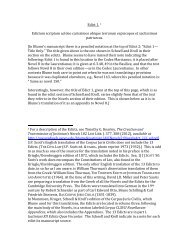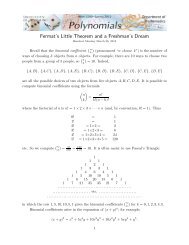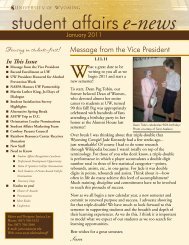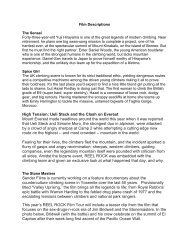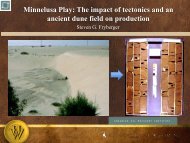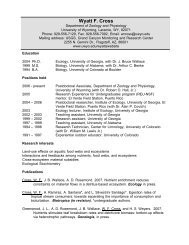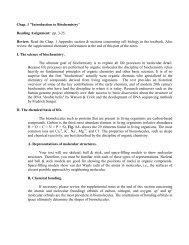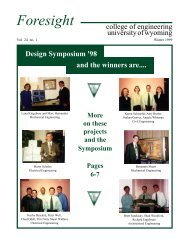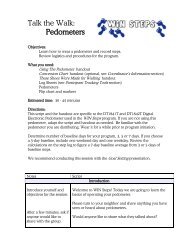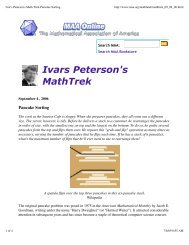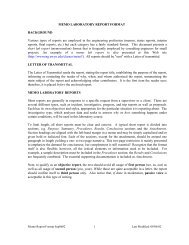Echinoderms and Chordates: Introduction to the phylum and fishes ...
Echinoderms and Chordates: Introduction to the phylum and fishes ...
Echinoderms and Chordates: Introduction to the phylum and fishes ...
Create successful ePaper yourself
Turn your PDF publications into a flip-book with our unique Google optimized e-Paper software.
<strong>Echinoderms</strong> <strong>and</strong> <strong>Chordates</strong>: <strong>Introduction</strong> <strong>to</strong> <strong>the</strong><br />
<strong>phylum</strong> <strong>and</strong> <strong>fishes</strong> (pp. 737 – 757,1211-1212)<br />
echinoderms<br />
Sharks<br />
Lancelet<br />
Bony <strong>fishes</strong>
Figure 34.1: phylogeny<br />
of <strong>the</strong> Deuteros<strong>to</strong>mes<br />
Animals that are not<br />
vertebrates are collectively<br />
known as invertebrates. Over<br />
95% of <strong>the</strong> known animal species<br />
are invertebrates, including <strong>the</strong><br />
echinoderms, hemichordates,<br />
<strong>and</strong> xenoturbellids.<br />
Pro<strong>to</strong>s<strong>to</strong>mes<br />
Coelom<br />
Triploblasty<br />
Bilateral symmetry<br />
Deuteros<strong>to</strong>me<br />
development<br />
Deuteros<strong>to</strong>mes<br />
This <strong>phylum</strong> includes<br />
vertebrates: sharks,<br />
bony <strong>fishes</strong>, amphibians,<br />
reptiles (including birds),<br />
<strong>and</strong> mammals
<strong>Echinoderms</strong> have a water vascular system.<br />
Figure 34.3<br />
Opening <strong>to</strong> exterior<br />
Podia<br />
Tube foot<br />
Podia project from <strong>the</strong> underside of <strong>the</strong> body.<br />
Podia
Mutable connective tissue<br />
Left pho<strong>to</strong>: when first <strong>to</strong>uched or h<strong>and</strong>led, <strong>the</strong> sea cucumber stiffens its<br />
connective tissue.<br />
Right pho<strong>to</strong>: after being rubbed vigorously, <strong>the</strong> body becomes so soft that it<br />
flows between <strong>the</strong> experimenters fingers.
Echinoderm diversity: Class Asteroidea<br />
(Sea stars)
Echinoderm diversity: Class Echinoidea<br />
(sea urchins, s<strong>and</strong> dollars)
Sea urchin eating kelp
Echinoderm<br />
diversity: Class<br />
Echinoidea<br />
To really underst<strong>and</strong><br />
how cool sea urchins<br />
are, I must tell you a<br />
s<strong>to</strong>ry about keys<strong>to</strong>ne<br />
species:<br />
sea otters<br />
as keys<strong>to</strong>ne species<br />
in <strong>the</strong> N. Pacific<br />
Otter number<br />
(% max. count)<br />
0<br />
(a) Sea otter abundance<br />
Grams per 0.25<br />
m2 (b) Sea urchin biomass<br />
Number per<br />
0.25 m2 100<br />
80<br />
60<br />
40<br />
20<br />
400<br />
300<br />
200<br />
100<br />
0<br />
10<br />
8<br />
6<br />
4<br />
2<br />
0<br />
1972 1985 1989 1993 1997<br />
Year<br />
Food chain before killer (c) Total kelp density<br />
whale involvement in chain<br />
Food chain after killer<br />
whales started preying<br />
on otters
Prey shift in killer whales after sea otters’ numbers<br />
have diminished.
Echinoderm diversity: Class Holothuroidea<br />
(Sea cucumbers)
Bizarre defense mechanisms in sea<br />
cucumbers:<br />
2. Eviscerate<br />
1. Expel cuverian tubules
Tardigrades (water bears) are very<br />
small animals that live on moss. They<br />
have segmented bodies <strong>and</strong> unjointed<br />
limbs. They grow by molting. Who are<br />
<strong>the</strong>y most closely related <strong>to</strong>?<br />
a. arthropods<br />
b. platyhelmin<strong>the</strong>s<br />
c. annelids<br />
d. Mollusks<br />
e. nema<strong>to</strong>des
Figure 34.1: The o<strong>the</strong>r large<br />
Deuteros<strong>to</strong>me <strong>phylum</strong>, <strong>the</strong> Chordata<br />
Animals that are not<br />
vertebrates are collectively<br />
known as invertebrates. Over<br />
95% of <strong>the</strong> known animal species<br />
are invertebrates, including <strong>the</strong><br />
echinoderms, hemichordates,<br />
<strong>and</strong> xenoturbellids.<br />
Pro<strong>to</strong>s<strong>to</strong>mes<br />
Coelom<br />
Triploblasty<br />
Bilateral symmetry<br />
Deuteros<strong>to</strong>me<br />
development<br />
Deuteros<strong>to</strong>mes<br />
This <strong>phylum</strong> includes<br />
vertebrates: sharks,<br />
bony <strong>fishes</strong>, amphibians,<br />
reptiles (including birds),<br />
<strong>and</strong> mammals
<strong>the</strong> 4 chordate characteristics
Sub-<strong>phylum</strong> Urochordata: <strong>the</strong> sea squirts or<br />
tunicates<br />
They are sessile<br />
<strong>and</strong> often colonial
Sea squirts possess pharyngeal slits:<br />
Fig 34.5a:<br />
But where is <strong>the</strong> no<strong>to</strong>chord? The dorsal hollow nerve cord?<br />
<strong>the</strong> postanal tail?
The larvae has <strong>the</strong>m!<br />
Larva<br />
Urochordata (tunicates)<br />
Water flow<br />
Pharyngeal gill slits<br />
Dorsal hollow nerve cord<br />
Water<br />
flow No<strong>to</strong>chord<br />
Pharyngeal gill slits<br />
Fig. 34.5<br />
Adult<br />
Muscular,<br />
post-anal tail
Sub<strong>phylum</strong> Cephalochordata:<br />
<strong>the</strong> lancelets<br />
Lancelet<br />
(Branchios<strong>to</strong>ma or<br />
Amphioxus)<br />
Fig. 34.5b
Fig. 34.12: Vertebrates<br />
possess elaborate heads with<br />
large brains <strong>and</strong> a cranium,<br />
<strong>and</strong> a vertebral column.<br />
Pharyngeal gill slits<br />
CHORDATA<br />
Dorsal hollow nerve cord<br />
No<strong>to</strong>chord<br />
Muscular, post-anal tail<br />
Outgroups <strong>to</strong> Chordata<br />
Vertebrae, cranium<br />
Jaws<br />
Lungs, internal bone (endoskele<strong>to</strong>n)<br />
Lobed fins<br />
Radial symmetry<br />
Water vascular system<br />
Loss of pharyngeal gill slits<br />
Limbs<br />
Amniotic egg<br />
Scales with hard keratin<br />
Loss of pharyngeal gill slits<br />
Lactation, fur<br />
<strong>Echinoderms</strong><br />
Acorn worms<br />
Xenoturbella<br />
Lancelets<br />
Tunicates<br />
Hagfish<br />
Lampreys<br />
Sharks, rays,<br />
skates<br />
Ray finned<br />
<strong>fishes</strong><br />
Coelacanths<br />
Lungfish<br />
AMPHIBIA<br />
Frogs, <strong>to</strong>ads<br />
Salam<strong>and</strong>ers<br />
Mammals<br />
REPTILIA<br />
Lizards, snakes<br />
Turtles<br />
Alliga<strong>to</strong>rs,<br />
crocodiles<br />
Birds<br />
Pro<strong>to</strong>s<strong>to</strong>mes<br />
Deuteros<strong>to</strong>mes<br />
CHORDATA<br />
CHORDATA<br />
VERTEBRATA<br />
GNATHOSTOMATA<br />
SARCOPTERYGII<br />
TETRAPODA<br />
AMNIOTA
Lampreys (jawless vertebrates)<br />
Sea lampreys (Petromyzon marinus) invaded Lake Ontario in 1830 from <strong>the</strong> sea.<br />
When <strong>the</strong> Well<strong>and</strong> Canal was built <strong>to</strong> bypass Niagara falls (1919), <strong>the</strong>y migrated <strong>to</strong><br />
<strong>the</strong> rest of <strong>the</strong> lakes. The catch of lake trout dropped from 15 million pounds at <strong>the</strong><br />
beginning of <strong>the</strong> 20th century <strong>to</strong> ≈ 300,000 in <strong>the</strong> 60s.
Spread of<br />
lampreys
Fig. 34.12: Vertebrates<br />
possess elaborate heads with<br />
large brains <strong>and</strong> a cranium<br />
<strong>and</strong> a vertebral column.<br />
The Gnathos<strong>to</strong>mata are<br />
vertebrates that possess<br />
jaws.<br />
Pharyngeal gill slits<br />
CHORDATA<br />
Dorsal hollow nerve cord<br />
No<strong>to</strong>chord<br />
Muscular, post-anal tail<br />
Outgroups <strong>to</strong> Chordata<br />
Vertebrae, cranium<br />
Jaws<br />
Lungs, internal bone (endoskele<strong>to</strong>n)<br />
Lobed fins<br />
Radial symmetry<br />
Water vascular system<br />
Loss of pharyngeal gill slits<br />
Limbs<br />
Amniotic egg<br />
Scales with hard keratin<br />
Loss of pharyngeal gill slits<br />
Lactation, fur<br />
<strong>Echinoderms</strong><br />
Acorn worms<br />
Xenoturbella<br />
Lancelets<br />
Tunicates<br />
Hagfish<br />
Lampreys<br />
Sharks, rays,<br />
skates<br />
Ray finned<br />
<strong>fishes</strong><br />
Coelacanths<br />
Lungfish<br />
AMPHIBIA<br />
Frogs, <strong>to</strong>ads<br />
Salam<strong>and</strong>ers<br />
Mammals<br />
REPTILIA<br />
Lizards, snakes<br />
Turtles<br />
Alliga<strong>to</strong>rs,<br />
crocodiles<br />
Birds<br />
Pro<strong>to</strong>s<strong>to</strong>mes<br />
Deuteros<strong>to</strong>mes<br />
CHORDATA<br />
CHORDATA<br />
VERTEBRATA<br />
GNATHOSTOMATA<br />
SARCOPTERYGII<br />
TETRAPODA<br />
AMNIOTA
While snorkeling, you come across an<br />
animal that is bilaterally symmetrical,<br />
has segments, a coelom, does not molt,<br />
<strong>and</strong> whose blas<strong>to</strong>pore forms <strong>the</strong> mouth.<br />
The animal could be a/an:<br />
a. Chordate<br />
b. annelid<br />
c. mollusk<br />
d. arthropod<br />
e. echinoderm
Class Chondrichthyes: Sharks, rays, <strong>and</strong> chimeras.<br />
sharks<br />
rays<br />
chimeras<br />
≈ 750 species of <strong>the</strong><br />
cartilagenous <strong>fishes</strong>.
The lateral line system that is used <strong>to</strong> detect tiny<br />
vibrations in <strong>the</strong> water<br />
Neuromasts (tiny<br />
pores that open in<strong>to</strong><br />
<strong>the</strong> lateral line)
Sharks have internal fertilization <strong>and</strong> a diversity of reproductive<br />
modes<br />
Claspers are paired<br />
sperm-transfer organs<br />
of male sharks<br />
Mating bull<br />
sharks<br />
oviparous:<br />
Shark<br />
eggs<br />
viviparous
Human propag<strong>and</strong>a…..
Bony Vertebrates<br />
This clade include 3 taxa (classes) of“<strong>fishes</strong>” <strong>and</strong> tetrapods (amphibians,<br />
reptiles <strong>and</strong> mammals).<br />
Examples of “<strong>fishes</strong>”:<br />
Hypopocampus<br />
erectus
Fig. 34.12: Bony Vertebrates<br />
include 3 taxa of fish, <strong>and</strong><br />
tetrapods (amphibians,<br />
mammals <strong>and</strong> reptiles):<br />
Pharyngeal gill slits<br />
CHORDATA<br />
Dorsal hollow nerve cord<br />
No<strong>to</strong>chord<br />
Muscular, post-anal tail<br />
Outgroups <strong>to</strong> Chordata<br />
Vertebrae, cranium<br />
Jaws<br />
Lungs, internal bone (endoskele<strong>to</strong>n)<br />
Lobed fins<br />
Radial symmetry<br />
Water vascular system<br />
Loss of pharyngeal gill slits<br />
Limbs<br />
Amniotic egg<br />
Scales with hard keratin<br />
Loss of pharyngeal gill slits<br />
Lactation, fur<br />
<strong>Echinoderms</strong><br />
Acorn worms<br />
Xenoturbella<br />
Lancelets<br />
Tunicates<br />
Hagfish<br />
Lampreys<br />
Sharks, rays,<br />
skates<br />
Ray finned<br />
<strong>fishes</strong><br />
Coelacanths<br />
Lungfish<br />
AMPHIBIA<br />
Frogs, <strong>to</strong>ads<br />
Salam<strong>and</strong>ers<br />
Mammals<br />
REPTILIA<br />
Lizards, snakes<br />
Turtles<br />
Alliga<strong>to</strong>rs,<br />
crocodiles<br />
Birds<br />
Pro<strong>to</strong>s<strong>to</strong>mes<br />
Deuteros<strong>to</strong>mes<br />
CHORDATA<br />
CHORDATA<br />
VERTEBRATA<br />
GNATHOSTOMATA<br />
SARCOPTERYGII<br />
TETRAPODA<br />
AMNIOTA
Fig. 34.12: Bony Vertebrates<br />
include 3 taxa of fish, <strong>and</strong><br />
tetrapods (amphibians,<br />
mammals <strong>and</strong> reptiles):<br />
Pharyngeal gill slits<br />
CHORDATA<br />
Dorsal hollow nerve cord<br />
No<strong>to</strong>chord<br />
Muscular, post-anal tail<br />
How would you describe <strong>the</strong><br />
phylogeny of fish (highlighted<br />
in blue)?<br />
a. Aphyletic<br />
b. Monophyletic<br />
c. Oligophyletic<br />
d. Paraphyletic<br />
e. polyphyletic<br />
Outgroups <strong>to</strong> Chordata<br />
Vertebrae, cranium<br />
Jaws<br />
Lungs, internal bone (endoskele<strong>to</strong>n)<br />
Lobed fins<br />
Radial symmetry<br />
Water vascular system<br />
Loss of pharyngeal gill slits<br />
Limbs<br />
Amniotic egg<br />
Scales with hard keratin<br />
Loss of pharyngeal gill slits<br />
Lactation, fur<br />
<strong>Echinoderms</strong><br />
Acorn worms<br />
Xenoturbella<br />
Lancelets<br />
Tunicates<br />
Hagfish<br />
Lampreys<br />
Sharks, rays,<br />
skates<br />
Ray finned<br />
<strong>fishes</strong><br />
Coelacanths<br />
Lungfish<br />
AMPHIBIA<br />
Frogs, <strong>to</strong>ads<br />
Salam<strong>and</strong>ers<br />
Mammals<br />
REPTILIA<br />
Lizards, snakes<br />
Turtles<br />
Alliga<strong>to</strong>rs,<br />
crocodiles<br />
Birds<br />
Pro<strong>to</strong>s<strong>to</strong>mes<br />
Deuteros<strong>to</strong>mes<br />
CHORDATA<br />
CHORDATA<br />
VERTEBRATA<br />
GNATHOSTOMATA<br />
SARCOPTERYGII<br />
TETRAPODA<br />
AMNIOTA
Fig. 34.12: Bony Vertebrates<br />
include <strong>the</strong> fish, <strong>and</strong><br />
tetrapods (amphibians,<br />
mammals <strong>and</strong> reptiles):<br />
Pharyngeal gill slits<br />
CHORDATA<br />
Dorsal hollow nerve cord<br />
No<strong>to</strong>chord<br />
Muscular, post-anal tail<br />
How would you describe <strong>the</strong><br />
phylogeny of Chondricthyes<br />
(sharks)?<br />
a. Aphyletic<br />
b. Monophyletic<br />
c. Oligophyletic<br />
d. Paraphyletic<br />
e. polyphyletic<br />
Outgroups <strong>to</strong> Chordata<br />
Vertebrae, cranium<br />
Jaws<br />
Lungs, internal bone (endoskele<strong>to</strong>n)<br />
Lobed fins<br />
Radial symmetry<br />
Water vascular system<br />
Loss of pharyngeal gill slits<br />
Limbs<br />
Amniotic egg<br />
Scales with hard keratin<br />
Loss of pharyngeal gill slits<br />
Lactation, fur<br />
<strong>Echinoderms</strong><br />
Acorn worms<br />
Xenoturbella<br />
Lancelets<br />
Tunicates<br />
Hagfish<br />
Lampreys<br />
Sharks, rays,<br />
skates<br />
Ray finned<br />
<strong>fishes</strong><br />
Coelacanths<br />
Lungfish<br />
AMPHIBIA<br />
Frogs, <strong>to</strong>ads<br />
Salam<strong>and</strong>ers<br />
Mammals<br />
REPTILIA<br />
Lizards, snakes<br />
Turtles<br />
Alliga<strong>to</strong>rs,<br />
crocodiles<br />
Birds<br />
Pro<strong>to</strong>s<strong>to</strong>mes<br />
Deuteros<strong>to</strong>mes<br />
CHORDATA<br />
CHORDATA<br />
VERTEBRATA<br />
GNATHOSTOMATA<br />
SARCOPTERYGII<br />
TETRAPODA<br />
AMNIOTA
Fig. 34.12: Bony Vertebrates<br />
include <strong>the</strong> fish, <strong>and</strong><br />
tetrapods (amphibians,<br />
mammals <strong>and</strong> reptiles):<br />
Pharyngeal gill slits<br />
CHORDATA<br />
Dorsal hollow nerve cord<br />
No<strong>to</strong>chord<br />
Muscular, post-anal tail<br />
Although, <strong>fishes</strong> are<br />
paraphyletic,<strong>the</strong> “fish” are<br />
composed of 6 monophyletic<br />
lineages (see 6 blue lines)<br />
Outgroups <strong>to</strong> Chordata<br />
Vertebrae, cranium<br />
Jaws<br />
Lungs, internal bone (endoskele<strong>to</strong>n)<br />
Lobed fins<br />
Radial symmetry<br />
Water vascular system<br />
Loss of pharyngeal gill slits<br />
Limbs<br />
Amniotic egg<br />
Scales with hard keratin<br />
Loss of pharyngeal gill slits<br />
Lactation, fur<br />
<strong>Echinoderms</strong><br />
Acorn worms<br />
Xenoturbella<br />
Lancelets<br />
Tunicates<br />
Hagfish<br />
Lampreys<br />
Sharks, rays,<br />
skates<br />
Ray finned<br />
<strong>fishes</strong><br />
Coelacanths<br />
Lungfish<br />
AMPHIBIA<br />
Frogs, <strong>to</strong>ads<br />
Salam<strong>and</strong>ers<br />
Mammals<br />
REPTILIA<br />
Lizards, snakes<br />
Turtles<br />
Alliga<strong>to</strong>rs,<br />
crocodiles<br />
Birds<br />
Pro<strong>to</strong>s<strong>to</strong>mes<br />
Deuteros<strong>to</strong>mes<br />
CHORDATA<br />
CHORDATA<br />
VERTEBRATA<br />
GNATHOSTOMATA<br />
SARCOPTERYGII<br />
TETRAPODA<br />
AMNIOTA
operculum<br />
The ray-finned <strong>fishes</strong> have all sorts of fins<br />
that can be greatly modified.<br />
triggerfish Scorpion fish
Traits of ray-finned <strong>fishes</strong>:<br />
gills<br />
swimbladder
Fig. 34.12: The aquatic bony<br />
vertebrates also include <strong>the</strong><br />
lung<strong>fishes</strong> (a lobe-finned<br />
fish).<br />
Pharyngeal gill slits<br />
CHORDATA<br />
Dorsal hollow nerve cord<br />
No<strong>to</strong>chord<br />
Muscular, post-anal tail<br />
Outgroups <strong>to</strong> Chordata<br />
Vertebrae, cranium<br />
Jaws<br />
Lungs, internal bone (endoskele<strong>to</strong>n)<br />
Lobed fins<br />
Radial symmetry<br />
Water vascular system<br />
Loss of pharyngeal gill slits<br />
Limbs<br />
Amniotic egg<br />
Scales with hard keratin<br />
Loss of pharyngeal gill slits<br />
Lactation, fur<br />
<strong>Echinoderms</strong><br />
Acorn worms<br />
Xenoturbella<br />
Lancelets<br />
Tunicates<br />
Hagfish<br />
Lampreys<br />
Sharks, rays,<br />
skates<br />
Ray finned<br />
<strong>fishes</strong><br />
Coelacanths<br />
Lungfish<br />
AMPHIBIA<br />
Frogs, <strong>to</strong>ads<br />
Salam<strong>and</strong>ers<br />
Mammals<br />
REPTILIA<br />
Lizards, snakes<br />
Turtles<br />
Alliga<strong>to</strong>rs,<br />
crocodiles<br />
Birds<br />
Pro<strong>to</strong>s<strong>to</strong>mes<br />
Deuteros<strong>to</strong>mes<br />
CHORDATA<br />
CHORDATA<br />
VERTEBRATA<br />
GNATHOSTOMATA<br />
SARCOPTERYGII<br />
TETRAPODA<br />
AMNIOTA
Lung<strong>fishes</strong> (6 species)<br />
are found in Africa,<br />
South America, <strong>and</strong><br />
Australia. All have a pair<br />
of lungs.
Barreleye fish have a<br />
transparent “forehead”<br />
<strong>and</strong> eyes that can pivot!



